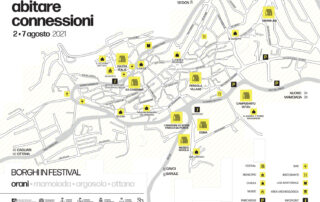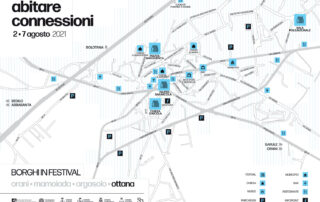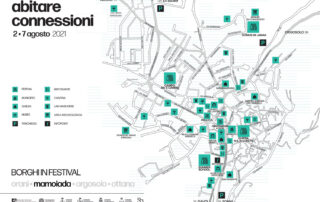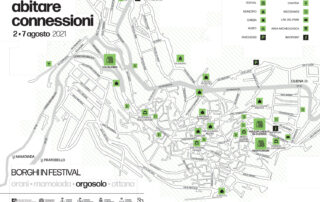Living Connections
“My choice would consist of the recovery of the whole country not an intervention with some sculpture, graffiti in a corner that would have no meaning and would count for nothing, but a total intervention, that is, intervening in the country, whitewashing all the houses, running the arbors freely that tend to do so despite continuous discouraging interventions.”
Constantine Nivola
Living Connections is not “just” a festival, but much more. Inspired by the lesson of Constantino Nivola and the green texture of pergola weaving the threads and bonds of communities, the Festival, is envisioned as a “total intervention” that will help refound public space, weave relationships, unravel conflicts, and transform relationships among people, bringing back the community in the square, in the streets, in the hidden nooks and crannies between the curves of intricate alleyways in which typical granite and stone dwellings face each other, on the steps of churches, and along picturesque routes set in a rugged, wild and picturesque landscape. From August 2 to 7, Mamoiada, Orani, Orgosolo and Ottana will be the setting for a rich artistic program that stems from the encounter and happy contamination between tradition and hyper-contemporaneity, between the richness of local traditions and visions from overseas called to measure themselves against a cultural heritage that is still intact. Objective is to produce knowledge through the participatory construction of new, more sustainable worlds, capable of putting at the center a community in and of relationship that reappropriates the commons by making them assets in a process of reconnecting the value chain, creating new social capital, and refounding neocommunity models reinterpreted through contemporary languages. Precisely because it is legacy-oriented, the Festival program is designed to be generative of ideas, visions, relationships, practices, and experiences capable of contributing to processes of participatory rewriting of the territory. In fact, local communities, institutions, cultural and economic operators, universities, study centers, individual artists and researchers will co-inhabit the territories to generate together unprecedented and plural narratives of new forms of inhabiting, producing and “doing” networking in an integrated system. New paths that, building on thelegacy of mutual and collaborative societies, know how to propose scalable and sustainable economic models in a cross-sectoral logic. Artists will be invited to inhabit the places and the exhibition and performance paths, the result of production and training residencies, will be realized with the collaboration of local workers and operators and with the active involvement of the citizenry. In order to think about the potential of inland areas, the festival will include 4 mornings of training and collaborative learning by Sardarch and the School of Civil Economy on the topics of community management, youth leadership, cooperation, circular economy, culturally based territorial regeneration, community enterprises, commons, bottom-up activation processes and sustainable participatory governance. A path reserved for 20 young people from the territories and young people from the areas of the other winning festivals with the aim of creating a network of “change agents,” a hybrid community of practice, the school ties in with the moments of public debate that will animate the squares of the 4 villages to invite communities to actively participate in the reprogramming of their places of life and work, going into dialogue with local and national protagonists according to a highly interactive and performative format. Each day will be packed with cultural events ranging from the Community Workshops, dedicated to wise local traditions, to the section Sounds in Barbagia curated by the Lyric Theater Foundation to the rich public art program curated by Maria Paola Zedda with ZEIT in dialogue with local museum institutions, Nivola Foundation in Orani and Museum of Masks in Mamoiada, which significantly enrich the artistic program. In the evening, in fact, the villages will literally be traversed by the performative and scenic outcomes of the artistic residencies of Andreco in Ottana, Mara Cassiani in Mamoiada, Claudia Losi in Orgosolo, Cristian Chironi, Enzo Cosimi, Gianmarco Porru, and Fabio Saiu in Orani, while Tomàs Saraceno ‘s Aereocene will draw the connecting paths between the villages. The artists will co-produce their works together with performers, musicians, dancers, and citizen video makers and then leave room on the 7th for a grand final community party, a prelude to a journey that is intended to be kept alive and leave tangible signs in the territory of new relationships, alliances, practices, planning and a narrative that is the result of the interweaving of all artistic languages and strategic alliances destined to endure over time. One example is the collaboration with the Sardagna Film commission Foundation to produce video legacies that spread the message beyond the stone boundaries that often isolate us and for the discovery of places to inhabit with new film languages. And in the same direction should be read the collaborations with the DICAAR, called to think about a refounding and remodeling of frontier spaces, of marginal places that are rediscovered as hubs “not for an intervention with some sculpture, graffiti in a corner” but for a total intervention” (Costantino Nivola) and with theEuropean Institute of Design for construction workshops inspired by the shapes of the Oranian master. These are two interventions designed to restore beauty, belonging, knowledge and centrality to territories that are not standardized but still rich in history, culture, memory, meaning and that have long had only one nostalgia, that of the future. And it is to the future that the Festival looks by making young people the protagonists of the entire program, which has provided for the activation of a highly specialized cultural volunteer pathway designed as an opportunity for high education and the transfer of skills and knowledge.
“Rifare il Mondo,” curated by Maria Paola Zedda, is a festival within a festival, a path of site-specific artistic interventions where choreographers, visual artists, and performers are invited to a close dialogue with the territory
identifying for each center involved a research and crossing field. Tomàs Saraceno, Andreco, Enzo Cosimi, Mara Oscar Cassiani, Cristian Chironi, Claudia Losi, Carlos Amorales, have been involved in residency and participation paths that are then returned in performative and installation form during the days of the festival. Together with them, in an integrated program curated with the Nivola Museum and in particular with director Antonella Camarda, the visual and performative works of Gianmarco Porru and Fabio Sau together with Antonio Bissiri are presented, emphasizing the important role of the new generation of Sardinian artists in the current contemporary scene. Conceived as a collective journey, RIFYING THE WORLD., is an invitation to share a practice of coexistence that identifies in the relationship between human habitation and the life of other species an indispensable field of research, according to an itinerant route that crosses from village to village the traditions, memories, paths of resistance, fragilities of territories and by extension of the planet, reactivating millenary plots.
The artists were asked to “cross” the contexts, breaking boundaries, according to a circular design capable of connecting the villages with each other, first in the residency phases prior to the festival, and then collectively with the participants during the concluding event. Through a system of peregrinations and stops, millennia-old tales are retraced and local production systems related to the specific peculiarities of craft revisited by contemporary art practices through the perspectives and textures of a planetary ecology are traced. Each artist-in-residence writes a situated and choral path by reactivating specific forms of production and rituals, involving local groups and workshops, artists, and producers in a connective system.
AT LEAST HERE
–The program–
Epicenter of the festival is Orani from which the activation of territories with Cristian Chironi, which opens the solo exhibition Notes from My House is a Le Corbusier in the evocative spaces of the former Barracks and performatively narrates connections through radio dialogues conducted among the streets behind the wheel of the 127 chameleon, traversing, guided by the polychromes designed by the Swiss architect, the barbaric streets and amplifying through a radio and physical performance, the narratives that the festival creates.
Tied by the red thread connecting the relationship between architecture, art and the environment in the opening rises over the skies of Orani the participatory installation Aerocene conceived by Tomás Saraceno, a collective work consisting of a balloon, the result of a choral work as an invitation to participate in the challenge to build a Mapping Against Extinction, in an open-source and collaborative perspective that traces a symbolic moment of elevation through care of the land.
During the opening, a preview performance by artist Andreco, who is committed to environmental activism, leads into the Nivola Museum. On Aug. 3, also in Orani, Enzo Cosimi presents in the dazzling location of Campu Santu Vetzu Coefore in Barbagia, an investigation of Mediterranean dances inspired by Greek tragedy with particular reference to the role of the feminine and matriarchal models in a participatory and contamination path that will see the involvement of ballu tundu dancers from the territory. Starring in the performance is musician Lady Maru, active between Rome and Berlin, who grafts dark techno sounds with the dense musicality of traditional choirs.
Also on the 3rd, which can be visited for the entire day and for the duration of the festival, Gianmarco Porru ‘s installation Per mezzo di stelle, exhibited in San Marino on the occasion of Mediterranea19 School of waters, curated by Simone Frangi, Alessandro Castiglioni and A Natural Oasis? a long-term performance project that began in 2019, which, starting with a reading of Igor Stravinsky’s Le sacre du printemps, analyzes those community practices, such as pagan festivals related the cycles of production and nature, in the Mediterranean that use leisure time as a form of
aggregation. In this process, the work focuses on the body languages and choreographic spaces inhabited by individual and collective bodies at these ritual celebrations.
The festival on the 4th moves to Ottana where Andreco, an artist and environmental engineer fascinated by the remediation capabilities of plant organisms, with his parade for the environment focuses on the issue of the importance of plants in environmental restoration and phytodepuration of water, rereading an area that following the closure of the Enichem plant is strongly posing the issue of resignation and the future of post-industrial areas after the abandonment of the countryside. Bodies and institutions are involved to rethink the relationship between village and industrial space, to build a ritual chant and choral path through collaboration with the Tenore Santa Maria di Otzana of Ottana, musician Maria Antonietta Bosu and artisan Paolo Lai.
Mexican Carlos Amorales takes a traditional barbarian mask on a journey to an indigenous village of Purépecha descent in central Mexico, which in rebellion against drug trafficking and law enforcement corruption has formed an autonomous institutional form with its own currency and flag. The work thus binds in a symbolic path stories of resistance and liberation, of colonial abuse and reparation, through the reenactment of past and new rituals, in a transnational journey of cultural connections. The video work is on display at the Museum of Masks in Mamoiada.
Instead, the performance Spirit by Mara Oscar Cassiani, Aug. 5 in Mamoiada, is addressed to adolescents and with their participation: a journey based on the transition from the traditional vernacular masks of Sardinia to contemporary youth rituals, Digital Live Award, Romaeuropa. The project is a spectacular and installation analysis that is activated through a mixture of the trance rhythm of traditional ritual with that of digital electronic music.
With an interspecies dialogue that interrogates silkworm breeding and vanishing knowledge, Claudia Losi research in Orgosolo the sonorities and traditions between craftsmanship, sewing and embroidery, working on the relationships that from this tiny animal are generated in the world, thus activating the community of women weavers in Orgosolo, generating with them not only textile wefts, but also narratives, fables, reinforcing relationships (even in symbolic form) with the community. With Hand That Passes and Voices That Weave the artist questions the last weavers, connecting (through recordings and their reworking) to the sound fabric of manual labor, female in particular, the voice: the work song, the love song, the farewell song, the song that cradles, the song that heals will generate a first performative “device.”
It returns on the 7th to Orani for the final celebration, in an act of reconnection that is amplified by the presence of
Fabio Sau and Antonio Bissiri, who with Gaia The New Humanity invite a new contact with a nonviolently man-made world in a dawn performance in the surrounding woods. Also involved are Eventi Verticali, Mara Oscar Cassiani engaged in a DJset, and along with them, a great feast of choirs, artisans, masks, and performers converging in the village to rethink and relive together the choral.
Living Connections
Villages in Festival | August 2-7, 2021
Orani – Mamoiada – Orgosolo – Ottana
A project of Sardarch edited by Enrica Puggioni, Nicolò Fenu, Matteo Lecis Cocco Ortu
Artistic program curated by Maria Paola Zedda – ZEIT






